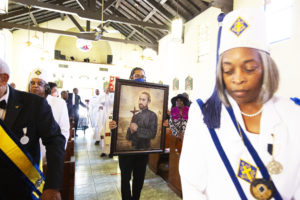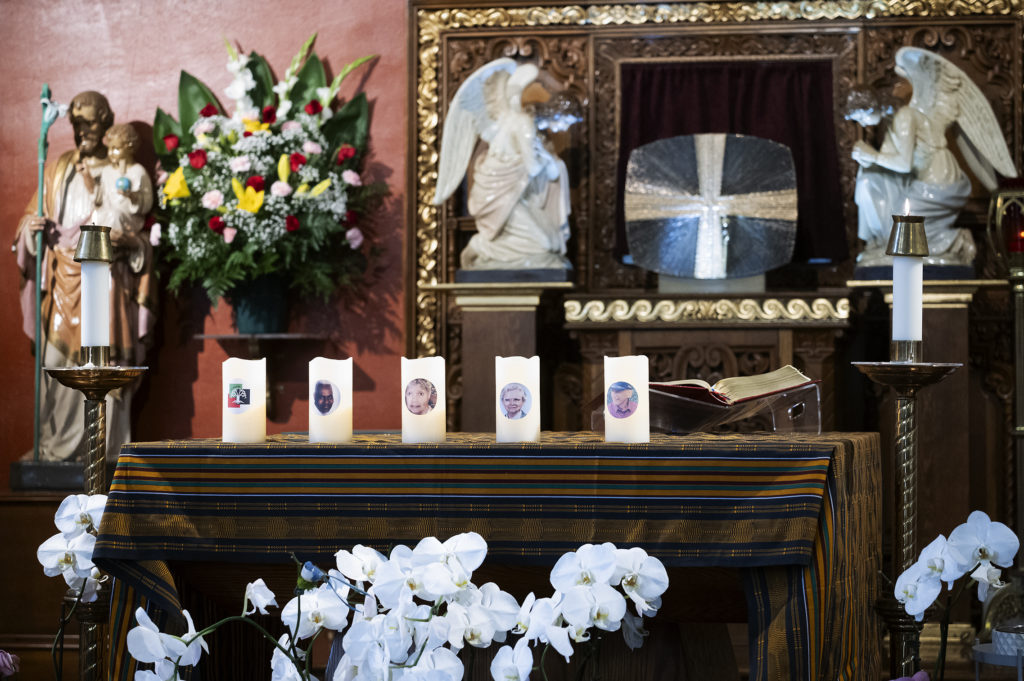As the Procession of Ancestors made its way down the center aisle at St. Odilia Church in Los Angeles, volunteers walked with candles illuminating the photo of a departed community member.
One by one the soul’s names were called out, each punctuated by the ringing of a bell. Tearful family members watched as the candles were placed on the altar.
This solemn march was the signature moment of the 14th annual African American Ancestral Mass held Nov. 11. The event celebrates the contributions of Black Catholics, their triumphs over adversity, and the sacred connection between generations.
“It was beautiful,” said Lisa Baxter, the daughter of “modern ancestor” John Coleman II, as she came with her husband and son. “My father was a man of faith, a man of virtue. He was definitely God’s disciple. … I wanted my son to understand he comes from a legacy of love.”
The other honorees were Lola Loudd, Sister Marianna Halsmer, SSS, and Stanley LeSassier. All were recognized for their work in ministry and dedication to their community.
The Mass, hosted by the African American Catholic Center for Evangelization (AACCFE) and partnering with the Knights of Peter Claver and Ladies Auxiliary, occurs every November during Black Catholic History Month.
Monica Lewis, a second cousin of LeSassier, was galvanized by the event. She came to the Mass for the celebration but left with a mission.
“That means to me to continue to fight the good fight, to fight for a seat at the table,” said Lewis, co-chair of African American Cultural Awareness Ministry at Holy Name of Jesus. “There’s been a shift toward multiculturalism, but Black Catholics tend to get lost in that concept.
“I believe we have a place here in the archdiocese and in our parishes.”

During the Ancestral Mass, a portrait of St. Peter Claver, “Apostle of Slaves,” was gifted to the church by the AACCFE. The Knights of St. Peter Claver was launched in 1909 when other Catholic apostolic groups didn’t accept Black members.
St. Odilia parishioners like the late Julius Pratt Sr. are credited for bringing the service order to California. Members were a strong presence at the Mass featuring pews full of men in black suits with blue sashes and women in white suits with matching fezzes. Pratt’s relatives — including his grandson, who is the current Grand Knight of Council 87 — were also in attendance.
“There’s a little bit of pressure because of the weight his name carries in the organization,” said Ryan Pratt. “I knew him as a wonderful loving grandfather. … He never judged anyone or had a harsh word. He tried to see the best in people.”
Black-and-white photos of mid-century parishioners were on display near the altar. Many of them were familiar faces to Cheryl Burnett, who recalled for Massgoers the days when St. Odilia was a hub for the Black Catholic community.
“It was a vibrant atmosphere, a lot of zeal and enthusiasm about building the Church, building the faith. I’ll never forget that,” Burnett said. “We had fashion shows, teas, and talent shows. Everybody had something to do in this parish, adults and children alike. I hope those ancestors are smiling down on what we’re doing.”
Before St. Odilia was founded in 1926, church life was not always so pleasant, said AACCFE Director Anderson Shaw. An influx of Black Southerners came West during the 1920s and found themselves unwelcome in some Catholic parishes.
“In many cases, they were forced to sit in the choir loft or the back of the church,” Shaw said. “They could not receive Communion before any white person.
“When St. Odilia was established as the ‘Negro National Church,’ people came from as far as San Bernardino and San Diego counties so they could worship in their own way while still being authentically Catholic.”

That comfort and support is still the goal of the AACCFE today. The organization serves 22 parishes in the archdiocese with predominantly African American and native African parishioners. While advancements have been made, Shaw acknowledged America’s 3 million Black Catholics still encounter racism.
A report released from the first session of the Synod of Bishops suggests the same. The report said “systems within the Church that create or maintain racial injustices need to be identified” and all Catholics should work to “eradicate the sin of racism.”
To further bolster the community, congregants would like to see the Black Catholics known as the “Holy Six” become saints. Venerables Pierre Toussaint, Henriette Delille, Augustus Tolton, and Servants of God Mary Lange, Julia Greeley, and Thea Bowman are still being considered for canonization. In honor of Black Catholic History Month, Holy Name of Jesus Church in Los Angeles is praying the Black Catholic History Rosary each week, which follows the traditional method of prayer but the Mysteries are dedicated to those up for sainthood.
At the close of the Ancestral Mass, the AACCFE Choir led a rousing version of “When The Saints Go Marching In.” Parishioners then attended a luncheon allowing old friends to catch up. Lola McAlpin-Grant and Sir Knight Elmer Pratt were part of the first graduating class of St. Odilia Catholic School and reminisced about class picnics and parties.
“With all those wonderful fond memories, I had to be here today,” said McAlpin-Grant with a wide grin. “This Mass is so special.”

